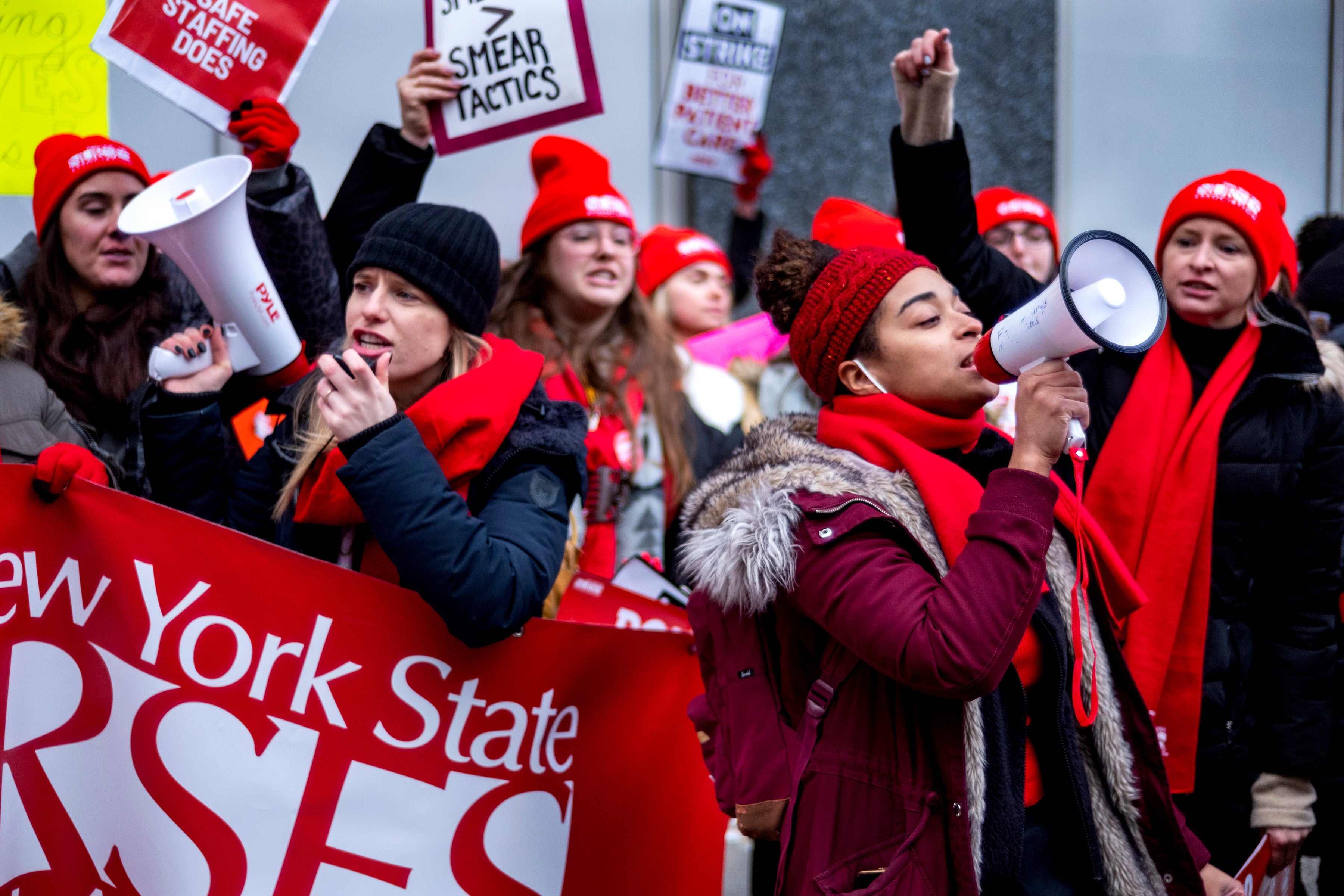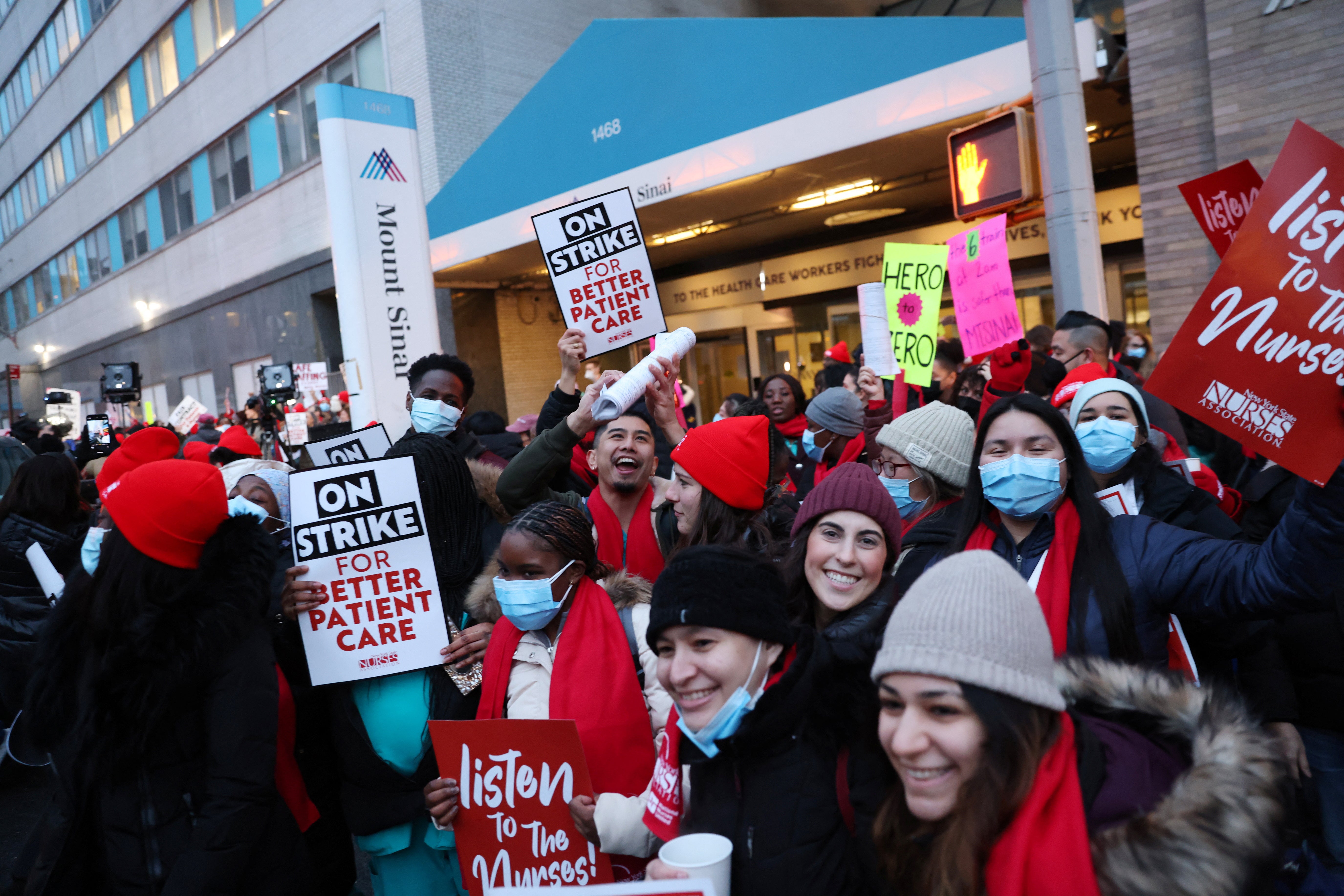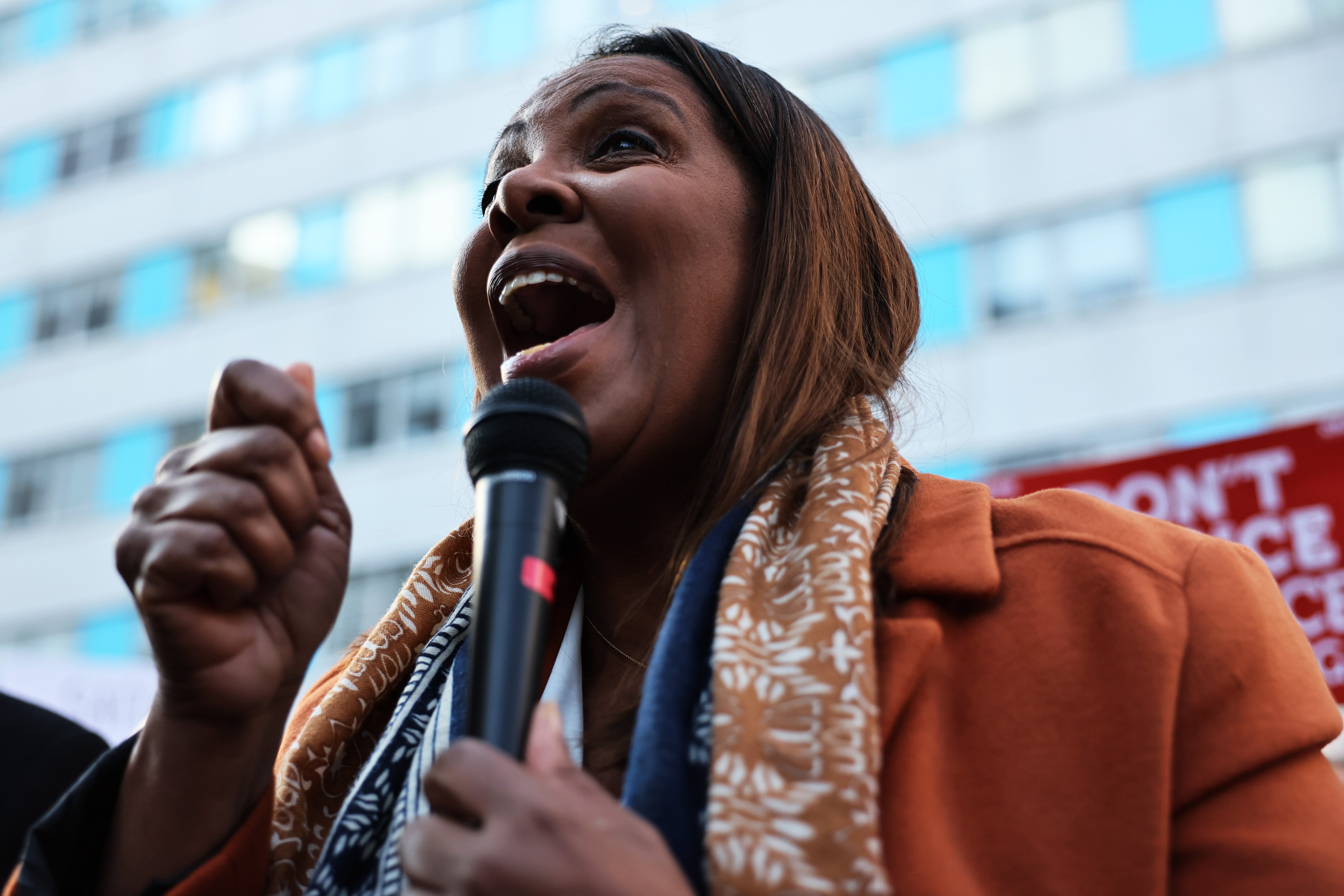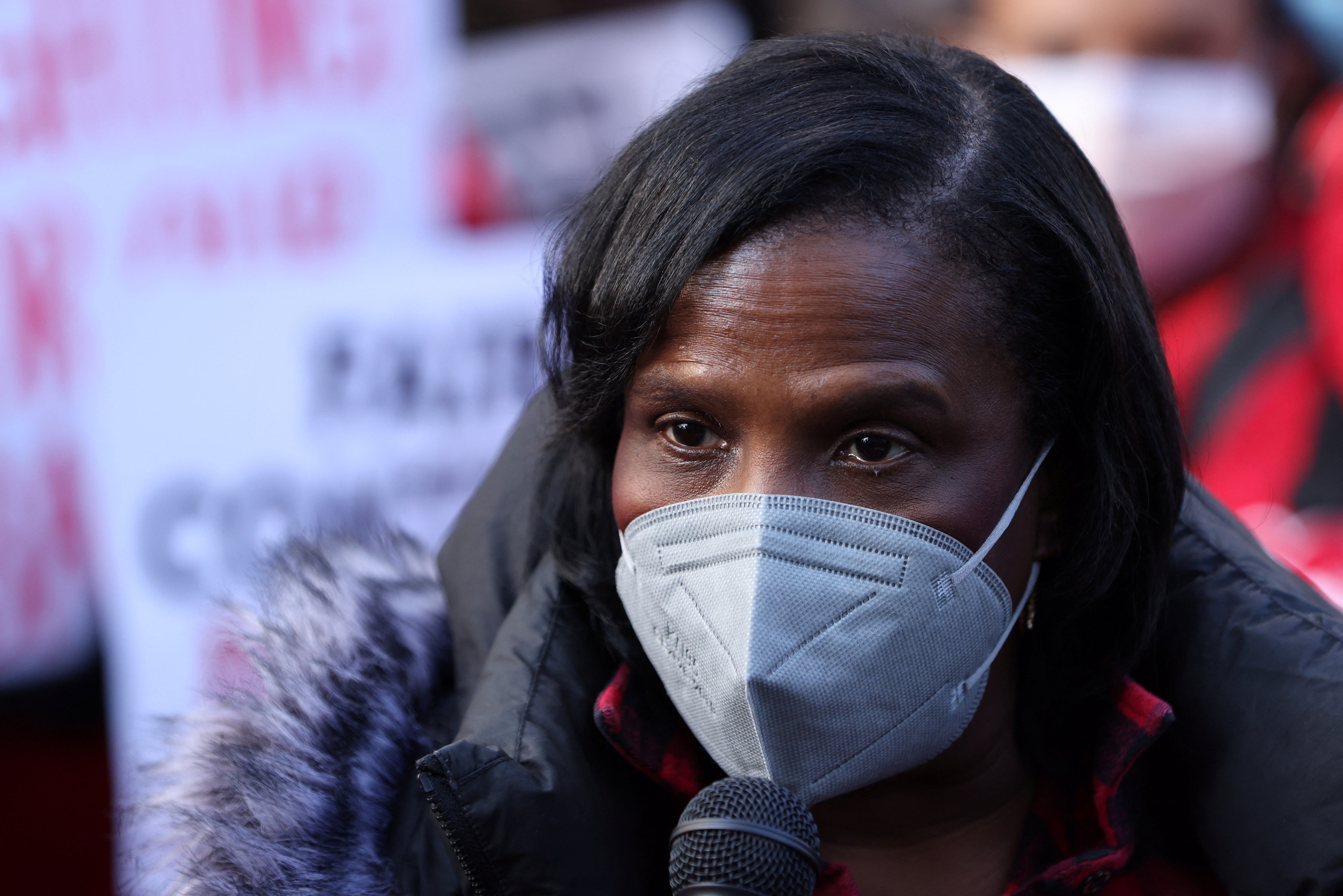‘Enough is enough’: Why 7,000 New York City nurses are on strike
Striking healthcare workers tell Alex Woodward how chronic staffing issues, inadequate pay and wave after wave of public health crises have put frontline nurses at a breaking point


Intensive care unit nurse Roxanna Garcia waved a sign reading “safe staffing saves lives” above a sea of red caps and posters across the street from Mount Sinai hospital in Harlem, where hundreds of striking nurses surrounded the renowned healthcare facility on 9 January.
Ms Garcia is among 7,000 New York nurses on strike for better wages and, critically, sustainable nurse-to-patient ratios that are currently burning out healthcare workers and endangering patients during an ongoing public health crisis, she said.
“It just makes it even harder than it needs to be,” she told The Independent. “It makes it unsafe when it doesn’t need to be for the patients and nurses. And it just adds to your stress when your focus is trying to keep someone alive.”
Ms Garcia has worked as a nurse for 10 years in both public and private healthcare systems in the city. She has spent the last eight years working in the ICU, including three years of the Covid-19 pandemic and during a wave of respiratory illness that has aggravated a persistent public health crisis.
“It’s already mentally taxing as it is,” she said. “So you add that extra element of having to take care of more patients than you should be – it really takes a toll.”
Following the expiration of their contracts in December, union workers with the New York State Nurses Association voted to authorise a strike if agreements could not be reached between eight hospital systems and the more than 16,000 nurses working in them, priming one of the largest nurses strikes in US history.
Last week, as union workers neared the 9 January deadline, tentative agreements were reached with nurses at several hospitals. But negotiations stalled at Mount Sinai’s Harlem hospital and three Montefiore facilities in The Bronx in the early morning hours before the 10-day strike warning deadline expired.
New York Governor Kathy Hochul has sought to broker negotiations between the nurses and affected hospitals and called for binding arbitration “so that all parties can swiftly reach a resolution,” her office said in a statement. Hospital officials said they welcomed arbitration but union officials declined the offer.
A response from the union called on the governor’s office to ramp up enforcement of nurse staffing laws.
“Governor Hochul should listen to frontline Covid nurse heroes and respect our federally protected labor and collective bargaining rights,” the union said. “Nurses don’t want to strike. Bosses have pushed us to strike by refusing to seriously consider our proposals to address the desperate crisis of unsafe staffing that harms our patients.”
At 6am, before sunrise, and without a tentative deal with their employers, nurses walked off the job and joined picket lines surrounding Mount Sinai and Montefiore’s hospitals.
Outside Mount Sinai, nurses and their supporters flanked both sides of the street surrounding the hospital’s campus on Madison Avenue. Passing cars and trucks honked their horns in support, joining noise makers, a brass band and a jubilant atmosphere powered by coffee and pizza wheeled in on wagons to feed the picket lines.

The strike has drawn widespread support from across city and state leadership, including New York Attorney General Letitia James, who rallied with a crowd outside Mount Sinai, and progressive US Senator Bernie Sanders, as well as union leaders and workers from across the city’s industries.
“Nurses don’t want to strike. We would rather be inside, taking care of their patients, but safely, and in a safe manner. Not in the conditions they’ve had us working the past five, 10 years. Enough is enough,” union president Nancy Hagans told a crowd gathered on the sidewalk outside Mount Sinai.
“Your boss at Mount Sinai had a choice,” she said. “These executives could have settled a fair contract. We gave them months of negotiations. They could have listened to the nurses. Do you hear us now, Sinai? … Respect your nurses, respect your patients, respect your community. Settle a fair contract now.”

One Mount Sinai healthcare worker, who has worked as an outpatient nurse for five years, held a sign reading “it’s always where’s my nurse, never how’s my nurse”.
“It’s never, ‘How are we going about doing it? Do we have the adequate supplies? Do we have adequate staffing?’ It’s always just demand after demand, and they just don’t give us enough resources,” the nurse, who asked that her name not be published over fears of retaliation from her employers, told The Independent.
“I was a new nurse for two years, and then Covid came. I was working at the height of it,” she said. “And in New York City, we saw everything firsthand … and also we were getting sick ourselves as the nurses. My coworkers got sick, coworkers I know in my hospital have died from Covid … and now it’s just unfair that hospitals were calling us heroes. People had signs out for us three years ago, and now where is all that? We need people to support us now, not just during the pandemic. We’re still here, people are still sick, and there’s still a pandemic.”

Mount Sinai’s emergency room nurses can care for more than a dozen patients, as many as 18 at a time, according to the union. Montefiore patients have been moved into hallways to alleviate overcrowding in emergency rooms, which sparked calls for state investigations, while nurses warn that they can see up to 70 patients a day.
Following years of organising and demands from healthcare workers, state lawmakers in 2021 mandated hospitals implement staffing ratios in intensive units, with enforcement from the state’s Department of Health by 1 January 2022.
But staff attrition and turnover rates, compounded by hospitals’ failure to recruit and retain more workers, have exploded the “understaffing crisis” fuelling nurses demands in the renewed contract battle, Ms Hagans told reporters in a virtual briefing on 5 January.
“Instead of wasting time and resources and money, they could … allocate to the nurses right now and improve staffing,” she said. “They need to come to the table and negotiate a fair contract.”
Over the last several years, nurses have endured chronic staffing issues on top of Covid surges, waves of respiratory illness, inflation concerns and the growing cost of living. Ms Hagans said that hospitals’ failure to hire new nurses has left hundreds of vacancies, including more than 700 openings at Montefiore and 500 at Mount Sinai.
Montefiore said it offered to create 170 new nursing positions. But Ms Hagans said new positions are not an issue when there are dozens of open positions, without any contractual agreements to enforce safe staffing ratios.
“It’s just gotten worse,” Ms Garcia told The Independent. “Things have been exacerbated, staffing has gotten worse, it’s getting more difficult to retain new nurses – so that’s something that unfortunately has continued throughout the years, even before Covid.”
Nurses are “adamant” that the state enforce the staffing mandate, she said.
Attorney General James also has pushed the governor’s office to enforce staffing rules, telling a crowd outside Mount Sinai that it is “so important” that the state’s Department of Health “get it right.”
“No excuses,” she said, pointing out to the crowd that hospitals have hired temporary workers to address staff shortages while nurses are on strike. “If you could do it now, then you should have done it then,” she said.

A statement from Mount Sinai as the strike was underway called the action “reckless”. The hospital accused union leadership of walking out of negotiations late on Sunday night.
“Our first priority is the safety of our patients,” the statement said. “We’re prepared to minimize disruption, and we encourage Mount Sinai nurses to continue providing the world-class care they’re known for.”
New York Assemblymember Jessica Gonzalez-Rojas, a member of the Assembly’s Committee on Health, said in a statement on Monday that nurses “did not walk out on us” while “New Yorkers were dying” during the pandemic.
“While the CEO was making a large salary, the nurses were risking their lives day after day to save New Yorkers,” she added. “It is past time that their work and sacrifice are recognized with safe staffing, better pay, and work conditions. Clapping will not feed their families and keep them in the profession.”
A statement from a Mount Sinai spokesperson last week said that the hospital system’s goal “is to reach an agreement that continues to provide our valued nurses with competitive compensation and benefits and ensures a safe, supportive working environment that enables them to provide exceptional care to all our patients across the diverse communities we serve.”
The union “refused to accept the exact same 19.1 per cent increased wage offer agreed to by eight other hospitals, including two other Mount Sinai Health System campuses,” the hospital said in a statement on Monday.
Montefiore’s CEO Philip O Ozuah said in a staff memo that the union rejected a “generous offer” that exceeded terms at other institutions and instead “walked away from the bedsides of our patients.”
“In my opinion this action was totally unnecessary, especially given how close we already were to a final agreement,” he added.

Montefiore is one of largest healthcare systems and private employers in The Bronx, with 10 hospitals and 200 clinics in the borough as well as neighbouring Westchester County and the lower Hudson Valley.
The union says that the system devotes two-thirds of its resources to its Westchester facilities, an area that is much smaller and whiter compared to its patient population in The Bronx, which continues to face one of the highest increases in hospital pricing and charges in the region, according to the union.
In 2020, Montefiore’s Ozuah made more than $6m, according to Crain’s.
Hospital profits at the onset of the pandemic and high rates of executive pay have made ongoing arguments for better nurse-to-patient ratios and more resources all the more frustrating, according to nurses.
Despite the broad economic fallout from the pandemic and rising healthcare costs, hospital executives in the state received $73m in bonuses in 2020. Two-thirds of nurses across the US, meanwhile, plan to quit in coming years, with 99 per cent reporting similarly chronic staffing issues at their workplace.
When union contract negotiations began in 2018 and 2019, Montefiore had committed to spending $66m over the next four years to boost staffing and improve ratios of patients to nurses. But staff numbers have instead plummeted, from 3,200 in 2018 to 2,700 last year, according to the union.
“People think, ‘Oh, you guys are nurses, you have money.’ … When you consider the type of work that we’re doing, working 14 hours a day, the type of responsibilities that we have, the kind of things that we always need to be accountable for at the end of the day – really it’s not proportional to what we should be getting,” Ms Garcia said. “And also, it makes it difficult to retain and get new nurses to come on board when they’re like, ‘Why should I come into such a toxic work environment?’”

Bracing for strikes, affected hospitals announced that some locations would divert ambulances, only schedule emergency procedures at certain facilities, and transfer or discharge eligible patients.
New York City Mayor Eric Adams said in a statement that New Yorkers “may experience impacts to operations, including possible delayed or limited service” and warned residents to “be prepared to seek an alternate facility in case their preferred hospital is impacted.”
The union has repeatedly stressed that its strike actions are not meant to deter patients from seeking care at impacted locations. Walking through hospital doors is not crossing the picket line, the union said. Members instead have invited patients to join them on the strike line after their visit.
“We want to be absolutely clear: If you are sick, please do not delay getting medical care, regardless of whether we are on strike,” the union said in a statement on Monday. “Patients should seek hospital care immediately if they need it. We would rather be the ones providing that care, but our bosses have pushed us to be out here instead.”
“Hopefully we come to a resolution. We don’t want to be here,” said Sheena Buat, standing among a group of cheering nurses who work in Mount Sinai’s outpatient care.
“We want fair wages. We’re hoping to get to a tentative agreement [and] hoping for the best,” she told The Independent. “Nobody wants to be out here.”
Join our commenting forum
Join thought-provoking conversations, follow other Independent readers and see their replies
Comments